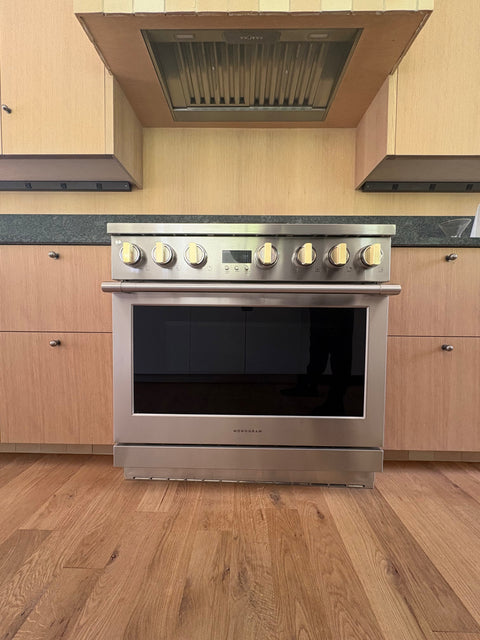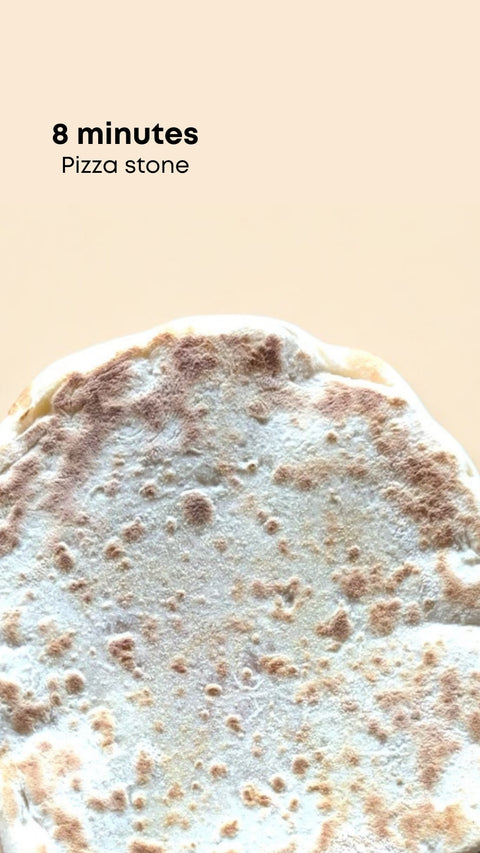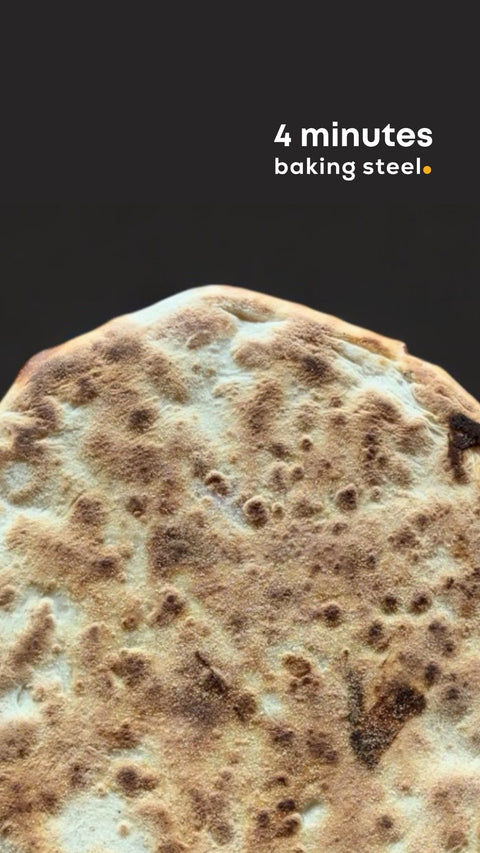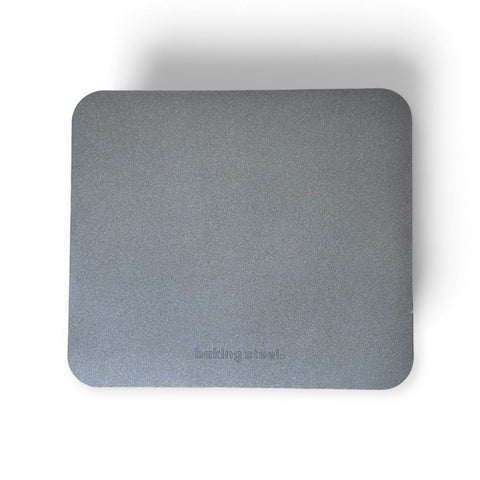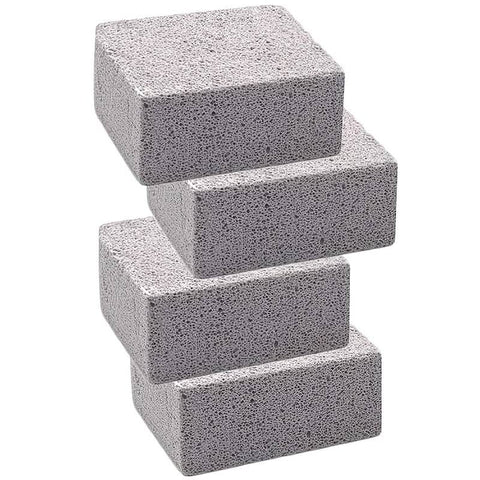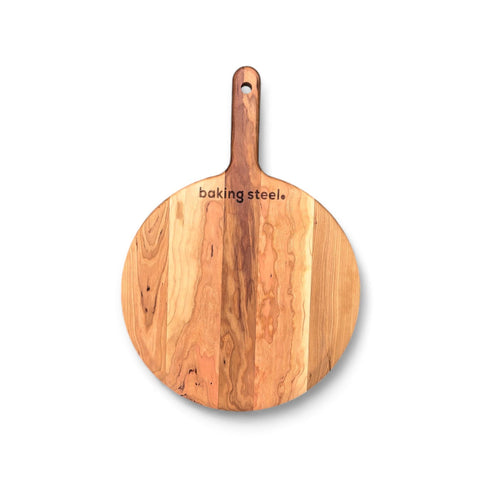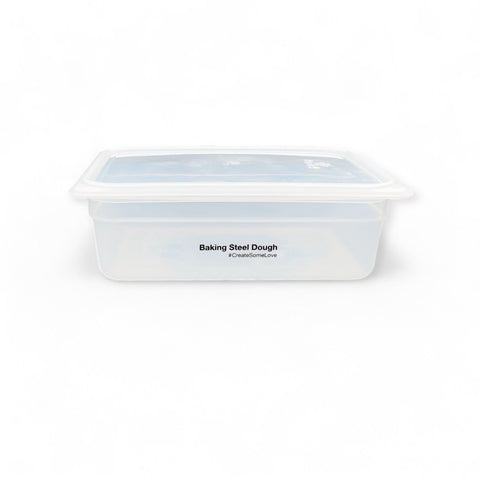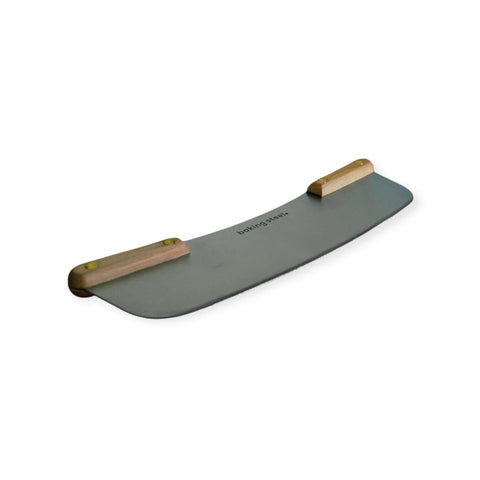No matter your setup, here’s how to dominate pizza night.
Gas or electric ovens for pizza? I’ve baked with both for years — and here’s what I’ve learned. I currently run both setups in my kitchen, and I’m a big fan of what Monogram is doing. Their electric wall ovens are rock solid, and their gas ranges deliver serious heat with precision. Whether you’re using gas, electric, or still deciding, the right setup (plus a Baking Steel) can help any oven dominate pizza night.

My Monogram Gas Oven. I have two Baking Steels inside.
Let’s Talk Ovens:
When I started baking pizzas at home, I was all in on gas. I loved the raw firepower, the broiler kicked on fast, and it felt like a real pizza oven. But over time, I came to appreciate the precision and consistency of electric ovens, especially when paired with a Baking Steel.
Here’s the truth: gas or electric ovens can deliver pizzeria-level results. If your oven is solid and you’re using a Baking Steel, you’re already in the game.
Whether you’re upgrading appliances or dialing in your current setup, this guide will help you get the most out of your oven and show you why a Baking Steel makes all the difference for homemade pizza.
🔌 Electric Ovens
Pros:
Often have more precise temperature control
Top-down broiler element for direct heat
Consistent, even baking chamber
Common in apartments and condos
Electric ovens are generally slower to preheat but tend to hold heat more evenly across the chamber once hot. The top-down broiler is key for activating the Maillard reaction (that charred, blistery look).
But here's the challenge: Most modern electric ovens use internal thermostats to keep the oven from getting too hot for too long, and that often causes the broiler to delay or cycle off completely.
Our fix? A simple oven hack: Preheat your oven at 450°F for about an hour. When you're ready to bake, switch it to broil. Because the oven is below its high-temp limit, the broiler coils will fire up almost instantly. If you preheat at 500°F or 550°F instead, the oven thinks it's too hot and actually tries to cool down — delaying broiler activation by minutes. That timing matters when your dough is ready to launch.
Watch Out For:
-
Broilers often cycle off if the oven is too hot
-
It can take longer to recover heat after opening the door
Tips:
-
Preheat to 450 F instead of 500°F to keep the broiler from throttling
-
Switch to broil 2 minutes before launching your pizza
-
Use your top rack for baking under the broiler with a Baking Steel
🔥 Gas Ovens
If you're baking pizza weekly, whether it's a Neapolitan-style in 2 minutes or a thick pan pie gas ovens offer some serious advantages. The broiler comes on almost instantly and, unlike electric broilers, stays on full tilt without cycling off. That steady blast of radiant heat paired with a Baking Steel can deliver restaurant-level results right from your kitchen.
For pan pizzas that require longer bake times and steady, even heat? Both gas and electric ovens shine, especially with a Baking Steel to stabilize the bake environment.
Pros:
-
Super fast heat-up
-
Moist baking environment (better oven spring)
-
Often more powerful bottom burners
-
Great for high-temp roasting and traditional cooking
Gas ovens bring power and quick response times. The ambient air tends to be more humid, which helps crusts rise fast without drying out. You’ll often get a more dramatic puff, especially with high-hydration dough.
Watch Out For:
-
Broiler drawer can be below the oven, which limits how you use it during active baking
-
Top-down heat can be weaker than electric
If your oven has a broiler drawer underneath, common in some NYC apartments and older gas ranges — it’s not ideal, but we’ve got a workaround:
Place your Baking Steel in the top half of the oven and bake your pizza with straight heat. Thanks to the Steel, you’ll still get that searing bottom crust.
Then, during the final minute of baking, move your pizza alone (no pan or Steel) into the broiler drawer to char the top. By that point, the base is set, and the drawer broiler just adds color and finishing touch.
Tips:
-
🔥 Pro Tip: Every time you fire up your gas oven, it releases a bit of water vapor into the baking chamber as a byproduct of combustion. That extra humidity actually benefits your dough — it encourages oven spring and gives your crust a more open, airy structure.
But it can also affect your tools over time. If you're storing your Baking Steel inside a gas oven (which we recommend), it's smart to beef up the seasoning with a few extra layers of oil. This adds a protective barrier and helps guard against moisture-related rust or wear. . That extra humidity helps with oven spring, but it can affect your gear over time. If you store your Baking Steel inside a gas oven (which we recommend), consider beefing up the seasoning — add a few extra layers to protect it from the elements.
-
Place your Baking Steel in the top third of the oven
-
If your broiler is in a drawer, preheat long and use the oven's max temp instead
-
Use convection if available to circulate heat
🍞 What About Bread in a Gas Oven?
We’ve heard the myth: “Gas ovens aren’t good for baking bread.” But I disagree — strongly.
In fact, in all my early tests — long before Baking Steel was a brand — I did everything in my gas oven at home. That’s where I learned how powerful it can be. Sure, gas ovens vent a bit more moisture, but with a little steam and a preheated Baking Steel, I was baking crusty, golden loaves with serious oven spring.
Gas ovens aren’t a limitation. They’re a powerful tool — for both pizza and bread — especially when paired with a Baking Steel and a little know-how.
🥇 Back-to-Back Pizza Baking
I love Friday nights like this one. If I had my way, I’d always use an electric wall oven, mostly because of the height. That vertical access makes it easy to slide pizzas in and out without crouching, especially when I’m running two Baking Steels at once.
But honestly? Give me two steels and any gas or electric oven, and I can feed a football team.
With one hot steel on the top rack and another on the bottom, you can launch, rotate, transfer, and relaunch without missing a beat. It’s all about flow, prep, and having the right gear, especially when using a Baking Steel in a home oven.
🔍 Features to Look for in a Pizza-Friendly Oven
If pizza’s a priority, one feature I always look for is convection — and luckily, most modern ovens have it built in.
Convection uses a fan to circulate hot air throughout the oven. The result? More even heat, fewer hot spots, and better browning across the board. Combine that airflow with a Baking Steel (or even two), and you’ve got a serious home pizza setup — whether you're team gas or electric oven.
Look for:
-
A strong broiler (ideally top-mounted)
-
True convection or European convection
-
Room for two racks — perfect for stacking Steels
🧼 Seasoning and Care for Your Steel
Whether you're using a gas or electric oven, proper seasoning is key to keeping your Baking Steel in great shape. And with a little TLC, your Steel will last a lifetime.
-
For gas ovens, be aware that moisture is introduced into the oven as a byproduct of combustion. That added humidity can be great for pizza crust, but it also means you should be a little more proactive with seasoning your steel.
-
Add extra layers of seasoning if you're storing your steel inside a gas oven long-term. It forms a barrier against moisture and prevents rust.
You can also use one of our Baking Steel Cleaning Bricks to keep the surface smooth and polished. It's the easiest way to remove baked-on bits and keep your steel performing like new, especially if you’re baking often.

🧱 What About Pizza Stones?
You might be wondering: what about pizza stones?
Pizza stones were the go-to tool for home pizza makers for years. They're inexpensive and they get the job done — until they don’t. The truth is, pizza stones are fragile. One wrong move, a drop of water on a hot surface, or just the wear of repeated heating and cooling, and they can crack — sometimes mid-bake.
They also take longer to heat up and don’t retain heat as well as steel. That means longer recovery time between pizzas and less crisp on the bottom.
If you’re making pizza once a month? A stone might work. But if you're serious about pizza — or just want pro-level crust every time — a Baking Steel is the upgrade you deserve.

🔁 Final Thought:
Don’t stress about your oven. We’ve baked world-class pies in both. A little knowledge + a Baking Steel = home pizza domination.
Need a Steel that works in either setup? Shop the Original →
🔥 FAQ: Gas vs. Electric Ovens for Pizza
What’s better for pizza, a gas or electric oven?
Both can deliver incredible pizza at home. Gas ovens heat up quickly and provide great ambient heat, while electric ovens often offer more consistent bottom heat. With a Baking Steel inside, either one becomes a pizza powerhouse.
Can I make restaurant-quality pizza in an electric oven?
Yes — especially if you use a Baking Steel. Electric ovens can deliver intense bottom heat, and when paired with the broiler, you can mimic that high-temp, pizzeria-style bake right at home.
Why isn’t my pizza crispy in a gas oven?
Gas ovens often vent moisture, which can affect crispiness. A preheated Baking Steel helps retain intense heat and evaporate moisture on contact, creating that perfect crisp bottom.
Do I need a pizza stone or steel to make good pizza at home?
You don’t need one, but if you want top-tier results — a crunchy, blistered crust with a soft interior — a Baking Steel will change your home pizza game forever.
How hot should my oven be for pizza?
Crank it as high as it goes — usually 500–550°F (260–290°C). Let your Baking Steel preheat for at least 45 minutes to store up that pizza-launching energy.
Is a broiler important for pizza?
Yes! Using the broiler for the first minute or two helps create the leopard spots and bubbly cheese that make pizza irresistible. In either a gas or eletric oven.
Want help figuring out your oven's quirks? Gas or electric oven? Email Andris@bakingsteel.com
Summary:
Wondering whether gas or electric ovens are better for making pizza at home? This guide breaks down the differences, especially when using a Baking Steel. We cover preheat times, broiler performance, heat consistency, and what kind of crust you can expect from each. Whether you're upgrading your oven or just want to optimize your current setup, this post helps you get the best possible bake.
